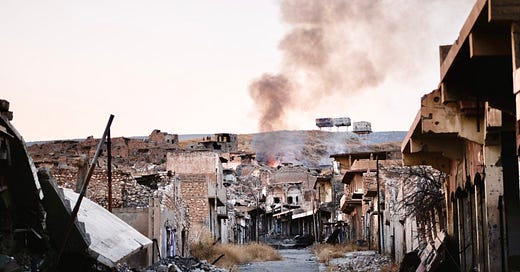How many people were killed when the RAF joined the American-led coalition to destroy Islamic State? How many during our wars in Afghanistan and Iraq? How many, for that matter, in the conflict between Russia and Ukraine?
Not only can most people not answer those questions but they haven’t thought to ask them in the first place. Not so in the case of Gaza, where such data forms the centrepiece of the debate. This morning, the BBC reports that more than 50,000 Palestinians have lost their lives there, according to “the territory’s Hamas-run health ministry”.
Naturally, our national broadcaster neglected to mention that according to the IDF, about half of the dead happened to be in combat at the time. But then, only three per cent of news reports include that small detail, so Auntie is hardly alone in that.
Look, let’s not rehearse the old arguments about the laughable fakery of the jihadi figures, the structural bias of the “United Nations and international institutions” — which, the BBC tells us, confirm that the data is “reliable” — the human-sacrifice strategy deployed by Hamas, the way the media makes that strategy worthwhile by dutifully amplifying the propaganda, the lengths to which Israel goes in evacuating civilians before attacks, the laws and norms of war, the history of Western military campaigns that have incurred far higher death tolls, or the ratio of combatant to civilian casualties, which, at about 1:1, speaks of an unparalleled level of restraint.
We won’t go into all that again. Enough of us have been shouting these arguments into the wind for the last 17 months to have reached the unavoidable conclusion that the vast majority of people simply have no interest in listening.
Instead, let’s just consider how unusual it is to debate the number of civilian casualties in the first place. When the RAF, American Air Force and Iraqi and Kurdish forces defeated Islamic State in Mosul in 2016-17, at least 9,000 civilians lost their lives. I’ve spoken with United States special forces spotters who were embedded with Iraqi troops in order to call in air strikes.
One told me that when the Iraqis reported a sniper position in an apartment block, for example, he radioed the airforce without any further questions and within minutes, the building was destroyed with 2,000lb bombs. Civilians? What civilians? He estimated that in some cases, 60 innocents were killed for every Islamic State jihadi.
Did anybody care? Nope. Those deaths were no less gruesome than the ones in Gaza that we see constantly on our televisions. Add our other battles against Islamic State and the death toll was far higher. Who took to the streets of London then? Where were the flares and the placards?
There are two differences. Firstly, that in Gaza we are talking about Israel, which means we are talking about the Jews. That conflict has always been given exceptional treatment by people in the West who use it as a playground for their own neuroses (I’m addressing this at some length in my new book).
Secondly, Islamic State jihadis simply did not have the propaganda apparatus that Hamas has built up over several decades. They did not have the ability to funnel footage of civilian casualties to their contacts in the media, secure in the knowledge that it would make the nightly news, with no questions asked about why we are only ever shown dead or injured civilians, never terrorists, and no curiosity about what this says about the censorship everted by Hamas over the pictures that are pumped into millions of sitting rooms around the world.
Because unlike Hamas, Islamic State did not have Western sympathy. The two jihadi groups both emerged from the same source, the Muslim Brotherhood, and both deploy similarly savage methods. But Hamas managed to capture hearts and minds in the democracies and as a result, we are eating out of the palms of their hands.
Addressing Parliament last week about the resumption of hostilities in Gaza, Sir Keir Starmer said: “The images of parents carrying their young children to hospitals that have emerged over the last few days are truly shocking, alongside the number of people who have been killed.” This short statement alone showed that the Prime Minister was as susceptible to Hamas propaganda as everybody else.
His policy position was influenced by “the images”, he admitted, which are censored by Hamas and used as part of the most successful propaganda campaign to target the West since the Cold War. And the fact that he was “shocked” by the casualty numbers was testament to the success of the other focus of Hamas propaganda, the manipulation of death toll data and the way it is presented.
As for the death toll from our war in Iraq, more than two decades on, estimates vary between 200,000 and about half-a-million. Our campaign in Afghanistan is thought to have claimed around 176,000 lives, but nobody knows the precise number either. Clearly, they should have employed some of the Hamas statisticians.
The fact that the Gazan terror group has managed to focus the debate entirely on the numbers of dead in the Strip and the issue of aid, sidelining both the plight of the Israeli hostages and the reasons for the war in the first place, is a monumental triumph for the forces of jihad. Shame on those journalists who enabled them.





